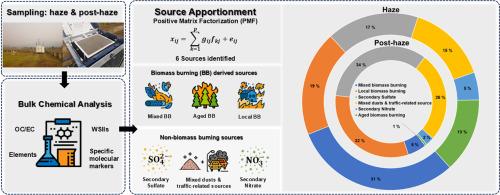揭示泰国北部雾霾的起源:利用靶向分子标记对PM2.5进行综合化学表征和来源解析
IF 6.3
2区 环境科学与生态学
Q1 ENVIRONMENTAL SCIENCES
引用次数: 0
摘要
泰国北部每年的雾霾越来越严重,影响着健康和环境。然而,由于气溶胶分子示踪剂的观测数据有限,对雾霾来源的量化仍然很差。本研究全面调查了2019年泰国北部农村地区雾霾期间和雾霾后PM2.5的化学成分,包括无机和有机化合物。霾期和霾后PM2.5平均浓度分别为87±36µg/m3和21±11µg/m3。PM2.5质量的主要来源是有机质,其次是水溶性无机离子和矿物粉尘。分子标记,包括左旋葡聚糖、脱氢枞酸和4-硝基儿茶酚,以及离子(Cl-和K+),被用来表征低霾(PM2.5 <;100µg/m3)和间歇性雾霾(PM2.5 >;100µg / m3)。轻度雾霾与农业废弃物燃烧产生的当地气溶胶有关,而间歇性雾霾与混合农业废弃物、软木和硬木燃烧产生的老化气溶胶有关。将这些分子标记纳入受体模型(正矩阵分解)的来源分配确定了三种不同的生物质燃烧来源:混合、局部和老化生物质燃烧,在雾霾期间贡献了PM2.5的31.9%、19%和13%。在后雾霾时期,贡献发生了变化,当地生物质燃烧(32%)与二次硫酸盐(34%)和混合粉尘和交通源(26%)相当。这些研究结果表明,区域和地方来源都是造成严重雾霾的原因,因此需要制定跨境合作的综合政策,并制定更严格的法规,以减少泰国北部和东南亚的生物质燃烧。本文章由计算机程序翻译,如有差异,请以英文原文为准。

Unveiling the origins of Northern Thailand’s haze: comprehensive chemical characterization and source apportionment of PM2.5 using targeted molecular markers
Annual haze in Northern Thailand has become increasingly severe, impacting health and the environment. However, the sources of the haze remain poorly quantified due to limited observational data on aerosol molecular tracers. This study comprehensively investigates chemical composition of PM2.5, including both inorganic and organic compounds throughout haze and post-haze periods in 2019 at a rural site of Northern Thailand. Average PM2.5 concentrations during haze and post-haze period were 87 ± 36 and 21 ± 11 µg/m3, respectively. Organic matter was the dominant contributor in PM2.5 mass, followed by water soluble inorganic ions and mineral dust. Molecular markers, including levoglucosan, dehydroabietic acid, and 4-nitrocatechol, and ions (Cl-, and K+), were used to characterize low haze (PM2.5 < 100 µg/m3) and episodic haze (PM2.5 > 100 µg/m3). Low haze is associated with local aerosols from agricultural waste burning, while episodic haze is linked to aged aerosols from mixed agricultural waste, softwood, and hardwood burning. Source apportionment incorporating these molecular markers in receptor modelling (Positive matrix factorization), identified three distinct biomass burning sources: mixed, local, and aged biomass burnings, contributing 31, 19 and 13 % of PM2.5 during haze period. During post-haze period, contributions shifted, with local biomass burning (32 %) comparable to secondary sulfate (34 %) and mixed dust and traffic sources (26 %). These findings demonstrate that both regional and local sources contribute to severe haze, highlighting the need for integrated policies for cross-border cooperation as well as stricter regulations to reduce biomass burning in Northern Thailand and Southeast Asia.
求助全文
通过发布文献求助,成功后即可免费获取论文全文。
去求助
来源期刊

Journal of Environmental Sciences-china
环境科学-环境科学
CiteScore
13.70
自引率
0.00%
发文量
6354
审稿时长
2.6 months
期刊介绍:
The Journal of Environmental Sciences is an international journal started in 1989. The journal is devoted to publish original, peer-reviewed research papers on main aspects of environmental sciences, such as environmental chemistry, environmental biology, ecology, geosciences and environmental physics. Appropriate subjects include basic and applied research on atmospheric, terrestrial and aquatic environments, pollution control and abatement technology, conservation of natural resources, environmental health and toxicology. Announcements of international environmental science meetings and other recent information are also included.
 求助内容:
求助内容: 应助结果提醒方式:
应助结果提醒方式:


